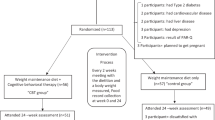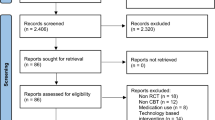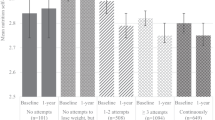Abstract
OBJECTIVE: To evaluate a modified cognitive–behavioural treatment (M-CBT) for weight management which addresses both the psychosocial costs and the physiological health risks of obesity, without a focus on weight loss.
DESIGN: Randomized controlled trial comparing M-CBT with standard cognitive–behavioural therapy (S-CBT).
SUBJECTS: Sixty-three overweight women with body mass index (BMI)≥28 kg/m2, mean age=47.5 and mean BMI=35.4.
MEASURES: Weight, waist and hip circumference, blood lipids, blood glucose, blood pressure, psychological well-being, depression, self esteem, stress, binge eating, eating style, body image, nutrient intake, aerobic fitness, activity levels, patient satisfaction with treatment.
RESULTS: Both M-CBT and S-CBT achieved improvements in a broad range of physical, psychological and behavioural variables. Weight loss in the S-CBT group was greater than in the M-CBT group immediately after treatment, but both groups lost weight. Participants in the M-CBT group continued to lose weight up to the 1 y follow-up. M-CBT was evaluated positively by participants.
CONCLUSIONS: Both M-CBT and S-CBT programmes were successful at inducing modest weight loss, as well as improving emotional well-being, reducing distress, increasing activity and fitness, improving dietary quality and reducing cardio-vascular disease risk factors. The improvements were maintained or continued at 1 y follow-up. These results suggest that treatment based on the new weight-control paradigm which emphasizes sustained lifestyle change without emphasis on dieting, can produce modest benefits to health and well-being.
This is a preview of subscription content, access via your institution
Access options
Subscribe to this journal
Receive 12 print issues and online access
$259.00 per year
only $21.58 per issue
Buy this article
- Purchase on Springer Link
- Instant access to full article PDF
Prices may be subject to local taxes which are calculated during checkout

Similar content being viewed by others
References
ADA report: Position of the American Dietetic Association: weight management . J Am Diet Assoc 1997 97: 71–74.
WHO . Obesity: preventing and managing the global epidemic. Report of a WHO Consultation on Obesity, Geneva, 3–5 June 1997 World Health Organization: Geneva 1998.
Sarlio-Lahteenkorva S, Stunkard A, Rissanen A . Psychosocial factors and quality of life in obesity Int J Obes Relat Metab Disord 1995 19 (Suppl): S1–S5.
Frost G, Masters K, King C, Kelly M, Hasan U, Heavens P, White R, Stanford J . A new method of energy prescription to improve weight loss J Hum Nutr Diet 1991 4: 369–373.
Rapoport L . Integrating cognitive behavioural therapy into dietetic practice: a challenge for dietitians J Hum Nutr Diet 1998 11: 227–237.
Gallagher C . Next please: a review of dietetic out-patient attendance Hum Nutr Appl Nutr 1984 38: 181–186.
Brownell KD, Jeffery RW . Improving long-term weight loss: pushing the limits of treatment Behav Ther 1987 18: 353–374.
Wilson GT . Behavioural treatment of obesity thirty years and counting Adv Behav Res Ther 1994 16: 31–75.
Rodin J, Radke-Sharpe N, Rebuffe-Scrive M, Greenwood MRC . Weight-cycling and fat distribution Int J Obes 1990 14: 303–310.
Lissner L, Odell PM, D'Agostino RB . Variability of body weight and health outcomes in the Framingham population New Engl J Med 1991 324: 1839–1844.
Haus G, Hoerr SL, Mavis B, Robison J . Key modifiable factors in weight maintenance: fat intake, exercise, and weight cycling J Am Diet Assoc 1994 94: 409–413.
Colditz GA, Willett WC, Stampfer MJ, London SJ, Segal MR, Speizer FE . Patterns of weight change and their relation to diet in a cohort of healthy women Am J Clin Nutr 1990 51: 1100–1105.
Foster GD, Sarwer DB, Wadden TA . Psychological effects of weight cycling in obese persons: a review and research agenda Obes Res 1997 5: 474–487.
Wardle J . Compulsive eating and dietary restraint Br J Clin Psychol 1987 26: 47–55.
Polivy J, Herman CP . Dieting and binging—a causal analysis Am Psychol 1985 40: 193–201.
Polivy J, Herman CP . Dieting and its relation to eating disorders. In: Brownell KD, Fairburn CG (eds) Eating Disorders and Obesity: a Comprehensive Handbook Guildford Press: New York 1995 pp 83–86.
Ciliska D . Beyond Dieting; Psychoeducational Interventions for Chronically Obese Women Brunner/Mazel: New York 1990.
Brownell KD . Whether obesity should be treated—Editorial Health Psychol 1993 12: 339–341.
Foreyt JP, Goodrick GK . Weight management without dieting Nutr Today 1993 4–9.
Parham ES . Is there a new weight paradigm? Nutr Today 1996 31: 155–161.
Robison J . Weight management: shifting the paradigm J Health Educ 1997 28: 28–34.
Ormichinski L, Harrison KR . Reductions of dieting attitudes and practices after participation in a non-diet lifestyle program J Can Diet Assoc 1995 56: 81–85.
Evans Young M . Dietbreaking: Having it All Without Having to Diet Hodder and Stoughton: London 1995.
Polivy J, Herman JP . Breaking the Diet Habit: the Natural Weight Alternative Basic Books: New York 1983.
Roughan P, Seddon E, Roberts J . Long-term effects of a psychologically based group programme for women preoccupied with body weight and eating behaviour Int J Obes 1990 14: 135–147.
Polivy J, Herman CP . Undieting: a program to help people stop dieting Int J Eat Disord 1992 11: 261–268.
Carrier KM, Steinhardt MA, Bowman S . Rethinking traditional weight management programs: a 3 y follow-up evaluation of a new approach J Psychol 1994 128: 517–535.
Mellin L, Croughanminihane M, Dickey L . The SOLUTION method—2 year trends in weight, blood pressure, exercise, depression and functioning of adults trained in developmental skills J Am Diet Assoc 1997 97: 1133–1138.
Ciliska D . Evaluation of two nondieting interventions for obese women West J Nurs Res 1998 20: 119–135.
Goodrick GK, Carlos Poston WS II, Timball KT, Reeves RS, Foreyt JP . Nondieting versus dieting treatment for overweight binge-eating women J Consult Clin Psychol 1998 66: 363–368.
Tanco S, Linden W, Earle T . Well-being and morbid obesity in women: a controlled therapy evaluation Int J Eat Disord 1998 23: 325–339.
Hetherington M, Davies M . Weight management: a comparison between non-dieting and dieting approaches Health Psychol Update 1998 32: 33–39.
Sbrocco T, Nedegaard RC, Stone JM, Lewis EL . Behavioural choice treatment promotes continuing weight loss: preliminary results of a cognitive–behavioural decision-based treatment for obesity J Consult Clin Psychol 1999 67: 260–266.
Foreyt JP, Carlos Poston WS II . What is the role of cognitive–behavior therapy in patient management? Obes Res 1998 6 (Suppl 1): 18S–22S.
Institute of Medicine, Thomas PR (ed) . Weighing the Options: Criteria for Evaluating Weight Management Programs. Committee to Develop Criteria for Evaluating the Outcomes of Approaches to Prevent and Treat Obesity National Academy Press: Washington, DC 1995.
SIGN . Obesity in Scotland. Integrating prevention with weight management. A National Clinical Guideline recommended for use in Scotland by the Scottish Intercollegiate Guidelines Network, pilot edition Edinburgh 1996.
Sobal J . Obesity and nutritional sociology: a model for coping with the stigma of obesity Clin Sociol Rev 1991 9: 125–141.
Rosen JC . Improving body image in obesity. In: Thompson JK (ed) Body Image, Eating Disorders, and Obesity American Psychological Association: Washington 1996, pp 425–440.
Grilo C . Treatment of obesity: an integrative model. In: Thompson JK (ed) Body Image, Eating Disorders, and Obesity American Psychological Association: Washington 1996, pp 389–423.
Wilson GT . Acceptance and change in the treatment of eating disorders and obesity Behav Ther 1996 27: 417–439.
Wardle J, Rapoport L . Cognitive–behavioural treatment of obesity. In: Kopelman P, Stock M (eds) Clinical Obesity Blackwell: London 1998, pp 409–428.
Garner DM, Rockert W, Olmsted MP, Johnson C, Coscina D . Psycho-educational principles in the treatment of bulimia and anorexia nervosa. In: Garner DM, Garfinkel PE (eds) Handbook of Psychotherapy for Anorexia Nervosa and Bulimia Guilford Press: New York 1985, pp 513–573.
Voss LD, Bailey RJR . Equipping the community to measure children's height: the reliability of portable instruments Arch Dis Child 1994 70: 469–471.
Van der Kooy K, Seidell JC . Techniques for the measurement of visceral fat: a practical guide Int J Obes Relat Metab Disord 1993 17: 187–196.
Friedewald WT, Levy RI, Fredrickson, DS . Estimation of the concentration of low-density lipoporotein cholesterol in plasma, without the use of the preparative ultracentrifuge Clin Chem 1972 18: 499–502.
Jamieson MJ, Webster J, Witte K, Huggins MM, MacDonald TM, De Beaux Petrie JC . An evaluation of the A&D UA-751 semi-automated cuff-oscillometric sphygmomanometer J Hypertens 1990 8: 377–381.
Goldberg D, Williams P . A User's Guide to the General Health Questionnaire NFER-Nelson: Windsor 1988.
Beck AT, Ward CH, Mendelson M, Mock J, Erbaugh J . An inventory for measuring depression Arch Gen Psychiat 1961 4: 53–63.
Rosenberg M . Society and the Adolescent Self-image (reprint edition) Wesleyan University Press: Middletown, CT 1989.
Cohen S, Kamarck T, Mermelstein R . A global measure of perceived stress J Health Soc Behav 1983 24: 385–396.
Johnston M, Wright S, Weinman J . Measures in Health Psychology: a User's Portfolio NFER-Nelson: Windsor 1995.
Gormally J, Black S, Daston S, Rardin D . The assessment of binge eating severity among obese persons Addict Behav 1982 7: 47–55.
Marcus MD, Wing RR, Hopkins J . Obese binge eaters: affect, cognitions, and response to behavioral weight control J Consult Clin Psychol 1988 56: 433–439.
Sherwood NE, Jeffery RW, Wing RR . Binge status as a predictor of weight loss treatment outcome Int J Obes Relat Metab Disord 1999 23: 485–493.
Stunkard A, Messick S . The three-factor eating questionnaire to measure dietary restraint, disinhibition and hunger J Psychosom Res 1985 29: 71–83.
French SA, Jeffery RW, Sherwood NE, Neumark-Sztainer D . Prevalence and correlates of binge eating in a nonclinical sample of women enrolled in a weight gain prevention program Int J Obes Relat Metab Disord 1999 23: 576–585.
Rosen JC, Srebnick D, Saltzberg E, Wendt S . Development of a body image avoidance questionnaire Psychol Assessment 1991 3: 32–37.
Bingham SA, Gill C, Welch A, Cassidy A, Khaw K, Sneyd MJ, Key TJA, Roe L, Day NE . Comparison of dietary assessment methods in nutritional epidemiology: weighted records vs 24 h recalls, food-frequency questionnaires and estimated-diet records Br J Nutr 1994 72: 619–643.
Bingham SA, Gill C, Welch A, Cassidy A, Runswick SA, Oakes S, Lubin R, Thurnham DI, Key TJA, Roe L, Khaw K, and Day NE . Validation of dietary assessment methods in the UK arm of EPIC using weighted records and 24 hour urinary nitrogen and potassium and serum vitamin C and carotenoids and biomarkers Int J Epidemiol 1997 26 (Suppl 1): S137–S151.
Katch FI, McArdle WD . Nutrition, Weight Control and Exercise Lea & Febiger: Philadelphia 1983.
Taylor HL, Jacobs DR Jr, Shucker B, Knudsen J, Lyons AS, DeBacker G . A questionnaire for the assessment of leisure time physical activities J Chronic Dis 1978 31: 741–755.
Wardle J, Rogers P, Judd P, Taylor M, Rapoport L, Green M, Nicholson Perry K . Randomised trial of effects of cholesterol-lowering dietary treatment on psychological function Am J Med 2000 108: 547–553.
Andersen RE, Wadden TA, Bartlett SJ, Vogt RA, Weinstock R . Relation of weight loss to changes in serum lipids and lipoproteins in obese women Am J Clin Nutr 1995 62: 350–357.
Dengel JL, Katzel LI, Goldberg AP . Effect of an American Heart Association diet, with or without weight loss, on lipids in obese middle-aged and older men Am J Clin Nutr 1995 62: 715–721.
Wadden TA, Bartlett SJ . Very low calorie diets: an overview and appraisal. In: Wadden TA, Van Itallie TB (eds) Treatment of the Seriously Obese Patient Guilford Press: New York 1992, pp 44–79.
Wadden TA . Treatment of obesity by moderate and severe caloric restriction Ann Intern Med 1993 119: 688–693.
Lichtman SW, Pisarka K, Berman ER, Pestone M, Dowling H, Offenbacher E, Weisel H, Heshka S, Matthews DE, Heymsfeld, SB . Discrepancy between self-reported and actual caloric intake and exercise in obese subjects New Engl J Med 1992 327: 1893–1898.
Acknowledgements
This work was supported in part through a grant from Lambeth, Southwark and Lewisham Health Authority.
Author information
Authors and Affiliations
Corresponding author
Rights and permissions
About this article
Cite this article
Rapoport, L., Clark, M. & Wardle, J. Evaluation of a modified cognitive–behavioural programme for weight management. Int J Obes 24, 1726–1737 (2000). https://doi.org/10.1038/sj.ijo.0801465
Received:
Revised:
Accepted:
Published:
Issue Date:
DOI: https://doi.org/10.1038/sj.ijo.0801465
Keywords
This article is cited by
-
Does Body Mass Index Confer Risk for Future Suicidal Thoughts and Behaviors? A Meta-analysis of Longitudinal Studies
Current Obesity Reports (2022)
-
Depression and obesity among females, are sex specificities considered?
Archives of Women's Mental Health (2021)
-
Effects of cognitive behavioral therapy on weight maintenance after successful weight loss in women; a randomized clinical trial
European Journal of Clinical Nutrition (2020)
-
Health, not weight loss, focused programmes versus conventional weight loss programmes for cardiovascular risk factors: a systematic review and meta-analysis
Systematic Reviews (2019)
-
Use of intervention mapping to adapt a health behavior change intervention for endometrial cancer survivors: the shape-up following cancer treatment program
BMC Public Health (2018)



